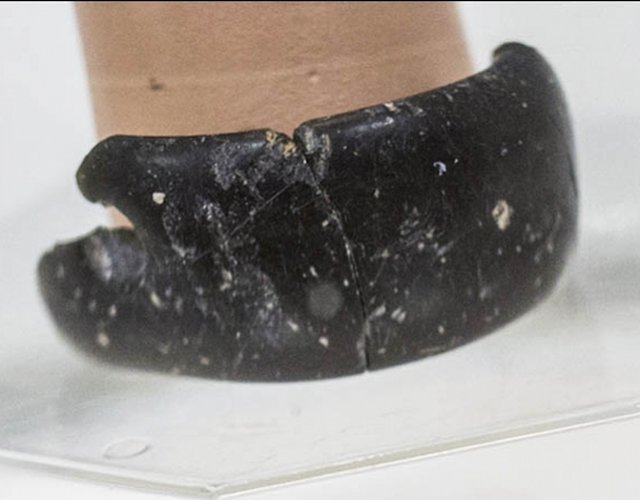MessageToEagle.com – Fragments of a stone bracelet made of drilled, worked and polished dark green chloritolite is considered the oldest-known jewelry of its kind.
It was unearthed in Denisova Cave in the Altai Mountains of Siberia in 2008 and is dated back 40,000 years.
‘New pictures show this ancient piece of jewellery in its full glory with scientists concluding it was made by our prehistoric human ancestors, the Denisovans, and shows them to have been far more advanced than ever realized.
The bracelet was found inside the famous Denisova Cave, in the Altai Mountains, which is renowned for its palaeontological finds dating back to the Denisovans, who were known as homo altaiensis, an extinct species of humans genetically distinct from Neanderthals and modern humans,’ reports The Siberian Times.

Made of chlorite, the bracelet was found in the same layer as the remains of some of the prehistoric people and is thought to belong to them.
What made the discovery especially striking was that the manufacturing technology is more common to a much later period, such as the Neolithic era. Indeed, it is not clear yet how the Denisovans could have made the bracelet with such skill.
There were found two fragments of the bracelet of a width of 2.7cm and a thickness of 0.9 cm. The estimated diameter of the find was 7cm. Near one of the cracks was a drilled hole with a diameter of about 0.8 cm. Studying them, scientists found out that the speed of rotation of the drill was rather high, fluctuations minimal, and that was there was applied drilling with an implement – technology that is common for more recent times,’ Derevyanko said.
‘The ancient master was skilled in techniques previously considered not characteristic for the Palaeolithic era, such as drilling with an implement, boring tool type rasp, grinding and polishing with a leather and skins of varying degrees of tanning.’
Chlorite was not found in the vicinity of the cave and is thought to have come from a distance of at least 200km, showing how valued the material was at the time. Dr Derevyanko said the bracelet had suffered damage, including visible scratches and bumps although it looked as if some of the scratches had been sanded down. Experts also believe that the piece of jewellery had other adornments to make it more beautiful.
‘Next to the hole on the outer surface of the bracelet can be seen clearly a limited polished zone of intensive contact with some soft organic material,’ said Dr Derevyanko.
‘Scientists have suggested that it was a leather strap with some charm, and this charm was rather heavy. The location of the polished section made it possible to identify the ‘top’ and ‘bottom’ of the bracelet and to establish that it was worn on the right hand.’
Located next to the Anuy River, about 150 km south of Barnaul, the Denisova Cave is a popular tourist attraction, such is its paleontological importance. Over the years a number of remains have been found there, including some of extinct animals such as the woolly mammoth. In total evidence of 66 different types of mammals have been discovered inside, and 50 bird species.
See also:
Denisovans: Ancient Teeth Reveal More Ancient Secrets Of Human Relatives
Denisovan DNA Detected In Modern South Asians – UCLA Scientists Reveal
The most exciting discovery was the remains of the Denisovans, a species of early humans that dated back as early as 600,000 years ago and were different to both Neanderthals and modern man.
In 2000 a tooth from a young adult was found in the cave and in 2008, when the bracelet was found, archaeologists discovered the finger bone of a juvenile Denisovan hominin, whom they dubbed the ‘X woman’. Further examination of the site found other artifacts dating as far back as 125,000 years.
The institute’s deputy director Mikhail Shunkov suggested that the find indicates the Denisovans – though now extinct – were more advanced than Homo sapiens and Neanderthals.
‘It is unlikely it was used as an everyday jewellery piece. I believe this beautiful and very fragile bracelet was worn only for some exceptional moments.’
‘In the same layer, where we found a Denisovan bone, were found interesting things; until then it was believed these the hallmark of the emergence of Homo sapiens,’ he said.
‘First of all, there were symbolic items, such as jewellery – including the stone bracelet as well as a ring, carved out of marble.’
The full details of the ring are yet to be revealed.
‘These finds were made using technological methods – boring stone, drilling with an implement, grinding – that are traditionally considered typical for a later time, and nowhere in the world they were used so early, in the Paleolithic era.
At first, we connected the finds with a progressive form of modern human, and now it turned out that this was fundamentally wrong. Obviously it was Denisovans, who left these things.’
This indicated that ‘the most progressive of the triad’ (Homo sapiens, Homo Neanderthals and Denisovans) were Denisovans, who according to their genetic and morphological characters were much more archaic than Neanderthals and modern human.’
But could this modern-looking bracelet have been buried with older remains?
The experts considered this possibility but rejected it, saying they believe the layers were uncontaminated by human interference from a later period.
MessageToEagle.com






